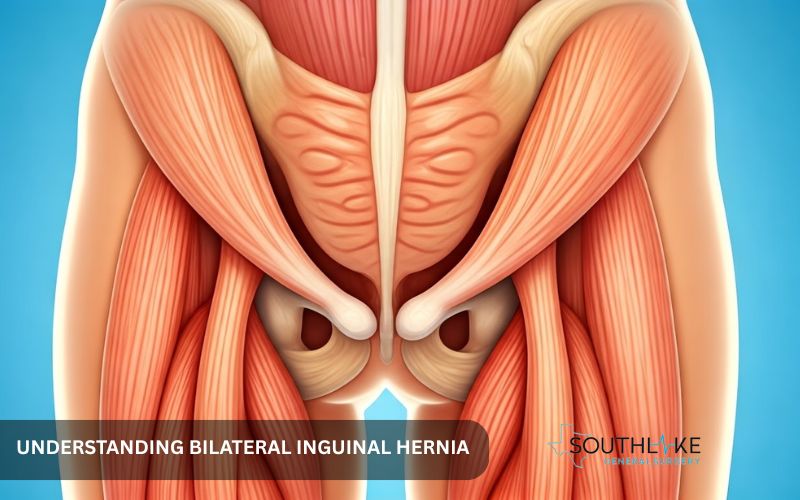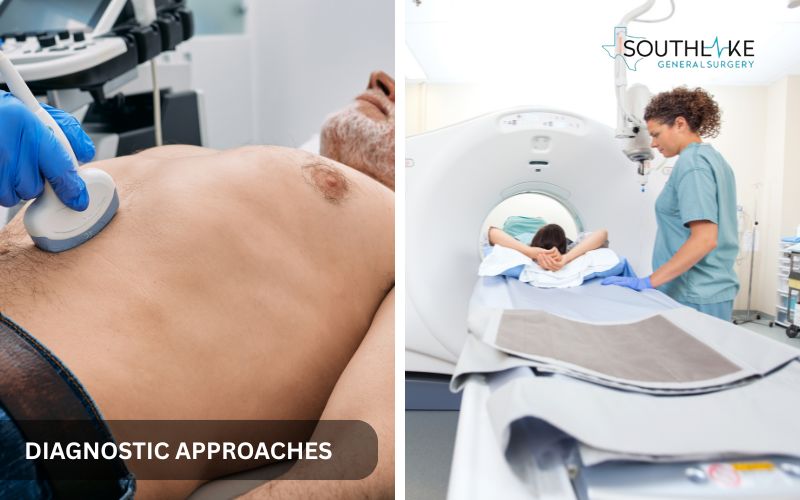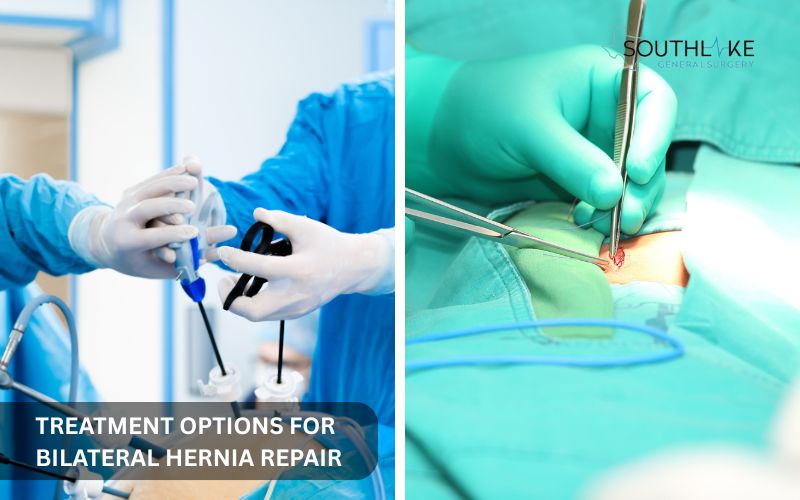Bilateral inguinal hernia repair is a surgery that treats hernias on both sides of the groin. If not addressed, these hernias could lead to discomfort and further complications. That is why it is important to have this surgery done as soon as possible for your health.
Bilateral inguinal hernias occur when tissue from the abdomen pushes through weak spots on both sides of the groin. This can cause pain and discomfort. If they are not treated, these hernias can become serious and may need surgery.
Surgery can be done by open surgery or laparoscopy. It is important to get treatment quickly for healing and your overall health. Understanding this condition and the treatments available are vital for those who want relief.
Key Highlights
- A bilateral inguinal hernia impacts both sides of the groin simultaneously.
- Surgery is the best treatment for bilateral inguinal hernias.
- Patients can choose between laparoscopic or open repair techniques. Each choice has its benefits.
- Timely assessment and intervention can avert significant issues, such as a strangulated hernia or a blocked bowel.
- Long-term results mostly depend on the surgeon’s skill and the type of repair used.
- Dr. Valeria Simone focuses on creating personalized treatment plans for hernia repair.
Understanding Bilateral Inguinal Hernia

Bilateral inguinal hernias are a complex health issue. Pain in the groin area may occur as a result. This pain can disturb how people live their lives each day. A bilateral inguinal hernia happens when tissue, like intestines or fat, pushes through weak spots in the abdominal wall on both sides of the pubic bone.
Overlooking hernias can result in significant issues, including a strangulated hernia. Understanding this condition and its foundational factors is essential. This understanding will help you choose the best surgical option.
What is a Bilateral Inguinal Hernia?
A bilateral inguinal hernia refers to a hernia that manifests on both sides of the groin region. It happens when tissue from the abdomen, like intestines or fat, pushes through the inguinal canal. The inguinal canal is a narrow passage in the abdominal wall, located close to the upper part of the inner thigh.
The inguinal canal can often have hernias. This occurs because it has openings that may become weaker over time. Factors such as aging, heavy lifting, or being born with problems can lead to this weakness. A common sign is a bulge near the pubic bone. This bulge usually gets bigger when you cough or lift something heavy.
Bilateral inguinal hernias can be more serious than unilateral hernias. This is due to both groin areas being affected. The aim of surgery is to fix these weak spots. This allows the body to work correctly and stops other problems from happening.
Why is it called “bilateral”?
The word “bilateral” means that hernias happen on both sides of the inguinal canal. This canal represents a minor passage within the lower abdominal wall, situated near the pubic bone. In bilateral inguinal hernias, tissue from the abdomen pushes through weak spots. This causes problems on both sides.
These hernias usually affect both the left and right groins at the same time. This makes them more complicated compared to unilateral hernias, which only affect one side. Effects on both sides can lead to more discomfort, pain, and a higher chance of complications.
When we consider the anatomy, there are weak spots on both sides of the abdominal cavity. This makes it hard to treat bilateral inguinal hernias. Skilled surgery is needed to repair these weaknesses equally. Knowing that they happen on both sides helps healthcare workers create a complete treatment plan.
Symptoms of Bilateral Inguinal Hernias

Bilateral inguinal hernias often appear as a bump or irritation in the groin area on both sides of the stomach. The early signs might include some swelling, feeling pressure, and a little pain, especially when you bend or lift things.
If the symptoms are not treated, they can get worse. This may lead to severe pain, difficulty moving, and serious issues like strangulation. Identifying the initial indicators can help you obtain timely assistance. This lowers risks and improves the long-term results for patients.
Common symptoms experienced by patients
Patients with bilateral inguinal hernias often experience these symptoms:
- You might notice a lump on both sides of your groin area. This lump can become bigger when you do physical activities like heavy lifting, coughing, or straining.
- The lump may go down when you are resting, but it comes back when you move.
- You could feel chronic groin pain that might spread to nearby areas.
- You might experience a feeling of pressure or heaviness in your lower abdomen.
- You may feel discomfort when bending, walking, or exercising due to strain on the hernia sites.
These symptoms can be bothersome and may worsen quickly. Patients should prioritize visiting a doctor at their earliest convenience. Treating the strain on both groin areas can help avoid serious complications.
Signs that you should seek medical advice
People who have bilateral inguinal hernias should look for signs that they need to see a doctor. Some important symptoms to pay attention to are:
- Strangulated Hernia: This occurs when the hernia gets stuck and can’t receive blood. This can lead to serious problems. Watch for these signs:
- A sharp, intense pain
- Swelling in the groin area
- Changes in the Hernia: If the hernia appears bigger, changes color, or won’t push back in, it could be getting worse.
- Urgent Signs: Look out for red lines or a fever along with groin pain. These are serious signs that mean you need to act quickly.
These serious issues can lead to blocked bowel sections. They can also induce nausea or lead to vomiting. It’s important to see a doctor before these symptoms get worse. By doing this, you can prevent more health problems and get the right diagnosis. Quick visits to a doctor can help avoid long-term damage or the need for emergency surgery.
Causes and Risk Factors
Bilateral inguinal hernias happen when there are weak spots in the abdominal wall. Doing things like heavy lifting, coughing for a long time, or straining on the toilet can raise pressure in the abdomen. This extra pressure can create new weak spots or make the existing ones worse.
Genetics play a role, but factors like lifestyle, age, and general health are also very important. If patients understand their risk factors, they can take steps to prevent hernias. Additionally, they have the option to seek medical help if needed.
Primary causes of Bilateral Inguinal Hernias
The main reason for bilateral inguinal hernias is weak spots in the abdominal muscles. Intense physical exertion may put significant strain on the abdominal wall. This force can lead to tissue protruding through those vulnerable spots. Other factors may also contribute to the problem.
- Chronic coughing: It creates steady pressure on the lower abdomen.
- Obesity: Having extra weight can strain the abdominal wall.
- Constipation: Pushing hard to go to the bathroom can increase pressure in the abdomen.
As time progresses, these issues could reduce the strength of the abdominal muscles. They can also cause pain in any weak spots. This might result in a hernia.
Hernias can happen after you have abdominal surgery. During surgery, small weak spots or tears may form. These weak areas can easily cause a hernia.
We can lower the chances of getting hernias by adjusting a few of our daily habits or medical routines. It also helps identify those who may need more support for the hernias they already have.
Who is at risk the most?
The factors that contribute to the occurrence of bilateral inguinal hernias are influenced by various elements. These factors include age, health, and family history. Certain individuals face a higher level of risk compared to others.
- Older Adults: As we age, our muscles can get weaker. This could increase the likelihood of hernias.
- Individuals Engaged in Heavy Lifting: Doing hard physical work can raise the chances of getting hernias.
- People with Connective Tissue Disorders: A family history of hernias can raise someone’s risk.
- Men: They have an increased probability of developing inguinal hernias compared to women.
- Overweight Individuals: Those who are very overweight or have health issues that cause strain when coughing or using the bathroom are at high risk.
Understanding these factors helps us act to avoid hernias. It also helps us find them early.
Diagnostic Approaches

Inguinal hernias can be found in a few ways. Doctors usually begin with a thorough physical exam to look for any lumps in the groin area. If they need more information, they might use imaging tests like ultrasound or CT scans.
These examinations allow doctors to visualize blood vessels and the abdominal cavity. These procedures are key for confirming the diagnosis and choosing the right treatment options.
Initial assessments and physical exams
A thorough physical exam is important during the first check for bilateral inguinal hernias. The healthcare team looks closely at the groin area and checks several key things:
- Look for any bumps or soreness. There can be a vulnerability in the abdominal wall if this happens.
- Discuss how patients feel about chronic groin pain, especially during heavy lifting.
- Review the patient’s medical history and any past surgeries.
This information helps us figure out the best way to check and help patients. It ensures they receive good care.
Imaging tests used in diagnosis
Several imaging tests assist physicians in accurately diagnosing inguinal hernias. These tests allow healthcare workers to see how much tissue is bulging out. The main imaging methods are:
- Ultrasound: It is often used because it provides real-time images without radiation.
- Magnetic Resonance Imaging (MRI): This may be used for more complicated cases. It is helpful when it’s necessary to distinguish a hernia from other issues.
- Computed Tomography (CT) scans: These provide clear cross-sectional images. They assist doctors in identifying problems like strangulated hernias, which help in forming a solid treatment plan.
Treatment Options for Bilateral Hernia Repair

Surgery is the main way to fix bilateral inguinal hernias. Dr. Valeria Simone offers two choices: open repair and laparoscopic repair. Both methods cater to each patient’s needs.
Customized treatment plans can lower the risk of problems and aid in recovery. Using synthetic mesh gives extra support. This helps with healing, lessens pain, and allows patients to return to their normal activities more quickly.
Overview of laparoscopic and open repair techniques
Laparoscopic and open repair are two methods used to treat inguinal hernias.
- Laparoscopic
Method:
- This method uses small cuts and a flexible tube with a camera.
- It gives doctors clear views.
- Patients feel less pain after surgery.
- This method helps patients recover faster and stay in the hospital for a shorter time.
- Open
Repair:
- This technique necessitates a larger incision to access the abdominal cavity directly.
- It might be better for complicated cases or hernias that come back.
The choice of method will depend on the patient’s health and the specifics of their hernia.
Why personalized treatment plans are crucial
Every patient has their own body traits and health issues. This is why tailored treatment plans are important for the best outcomes in hernia repair. A personalized plan considers several factors:
- Type of hernia
- Patient’s overall health
- Any other health concerns
This careful method helps choose the best type of surgery, whether it is laparoscopic or open. A plan like this lowers the risk of problems, speeds up recovery, and meets personal pain management needs. In the end, all this helps patients heal better and return to their normal activities.
Expected outcomes and recovery timeline
After surgery, most patients should look forward to these results concerning pain and recovery:
- Pain Reduction: Post-surgery, you may experience a reduction in pain.
- Return to Normal Activities: Most people can return to their normal activities in just a few weeks.
- Recovery Speed: A laparoscopic inguinal hernia repair allows for a quicker recovery compared to traditional open surgery. You can start light physical activities sooner.
- Full Recovery Timeline: A full recovery may take several months. Your health and the intricacy of the procedure will determine this.
- Healthcare Monitoring: It is essential for your healthcare team to monitor you during this period. They can help manage any issues that come up.
- Support and Healing: This support helps you heal properly and return to your daily life more quickly.
Conclusion
Knowing how to fix bilateral inguinal hernias is very important for good results. Before treatment, several tests can help diagnose the problem. These assessments may encompass basic evaluations and sophisticated imaging tools.
Creating a personalized treatment plan can really help with recovery. This can lower complications and allow you to return to normal activities sooner. Working with a dedicated healthcare team makes sure that both surgery and recovery run smoothly. This leads to happier patients and fewer risks linked to inguinal hernias.
Make an Appointment

Scheduled times with Dr. Valeria Simone at Southlake General Surgery provides individualized attention for bilateral inguinal hernias. She has a lot of experience and creates special treatment plans for each patient.
If you’re interested in exploring open surgery or laparoscopic surgery, Dr. Simone is available to discuss the associated risks, recovery, and healing journey. To set up your visit, call +1 (817) 748-0200 and start feeling better. Our healthcare team is here to assist you every step of the way.
Frequently Asked Questions
What is the success rate of repairing bilateral inguinal hernia?
Bilateral inguinal hernia repairs usually work for about 90% to 95% of patients. The outcome can vary based on the surgical procedure and the overall health of the patient. Many individuals experience a significant enhancement in their symptoms. The possibility of the hernia recurring is minimal if they adhere to the aftercare recommendations.
How long is the recovery period after surgery?
The time it takes to recover after surgery for an inguinal hernia can differ. Using laparoscopic surgery, the recovery period generally lasts between one to two weeks. However, with open repair surgery, it might take up to four weeks. Your overall health, age, and how you care for yourself after surgery can affect how quickly you feel better.
Medically Reviewed By: Dr. Valeria Simone MD
Board-certified General Surgeon at Southlake General Surgery, Texas, USA.
Follow us on Facebook and YouTube.
References:
- Sarli, L., Iusco, D. R., Sansebastiano, G., & Costi, R. (2001). Simultaneous repair of bilateral inguinal hernias. Surgical Laparoscopy Endoscopy & Percutaneous Techniques, 11(4), 262–267. https://doi.org/10.1097/00129689-200108000-00007
- Trindade, E. N., & Trindade, M. R. M. (2011). The best laparoscopic hernia repair. Annals of Surgery, 254(3), 541. https://doi.org/10.1097/sla.0b013e31822acfd6
- Aiolfi, A., Cavalli, M., Micheletto, G., Lombardo, F., Bonitta, G., Morlacchi, A., Bruni, P. G., Campanelli, G., & Bona, D. (2019). Primary inguinal hernia: systematic review and Bayesian network meta-analysis comparing open, laparoscopic transabdominal preperitoneal, totally extraperitoneal, and robotic preperitoneal repair. Hernia, 23(3), 473–484. https://doi.org/10.1007/s10029-019-01964-2
- Bansal, V. K., Misra, M. C., Babu, D., Victor, J., Kumar, S., Sagar, R., Rajeshwari, S., Krishna, A., & Rewari, V. (2013). A prospective, randomized comparison of long-term outcomes: chronic groin pain and quality of life following totally extraperitoneal (TEP) and transabdominal preperitoneal (TAPP) laparoscopic inguinal hernia repair. Surgical Endoscopy, 27(7), 2373–2382. https://doi.org/10.1007/s00464-013-2797-7
- Sajid, M. S., Kalra, L., Parampalli, U., Sains, P. S., & Baig, M. K. (2013). A systematic review and meta-analysis evaluating the effectiveness of lightweight mesh against heavyweight mesh in influencing the incidence of chronic groin pain following laparoscopic inguinal hernia repair. The American Journal of Surgery, 205(6), 726–736. https://doi.org/10.1016/j.amjsurg.2012.07.046

